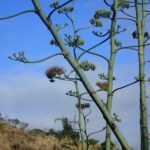
MAUI NATURE ALMANAC
community nature journal
Welcome to the Maui Nature Journal, a place to share your observations and experiences in the natural world. The format is basic: a sequential listing of entries, descriptions or interpretations of local nature, submitted whenever anyone is inspired to share. The goals:
- Co-create an archive of local nature observations.
- Learn from each other and create an ecologically literate culture, right here.
- Document ecological changes.
- Engage with and document our natural environment, so that we can better know, love, and care for this place, so that we can teach the keiki, malama the aina, and reinhabit the islands.
On a deeper level, a shared nature journal is a way to collectively celebrate all that this living place is, and to help each other see, hear, and understand. We are part of a dynamic, ever-unfolding matrix that we call cosmos, Earth, Maui, nature. This is an invitation to get to know some of the neighbors, like kolea, ‘ua’u kani, ‘o‘opu nakea, and wiliwili. An invitation to unplug for a while, go outside, slow down, notice, and savor the richness that reveals itself.
Every observation you share helps us all extend roots, shift consciousness, grow community. Your journal entries can originate anywhere from mauka to makai, from your backyard to the heart of the wilderness. Are you in the city? No problem, life abounds. And you don’t have to be a scientist, expert, or poet to participate. As Emerson said, each one of us can have “an original relation to the universe”, and “So shall we come to look at the world with new eyes.”
A shout out and a big mahalo to Tom Lake and the Hudson River Almanac for the inspiration!
To submit an entry to the Nature Journal, click HERE.
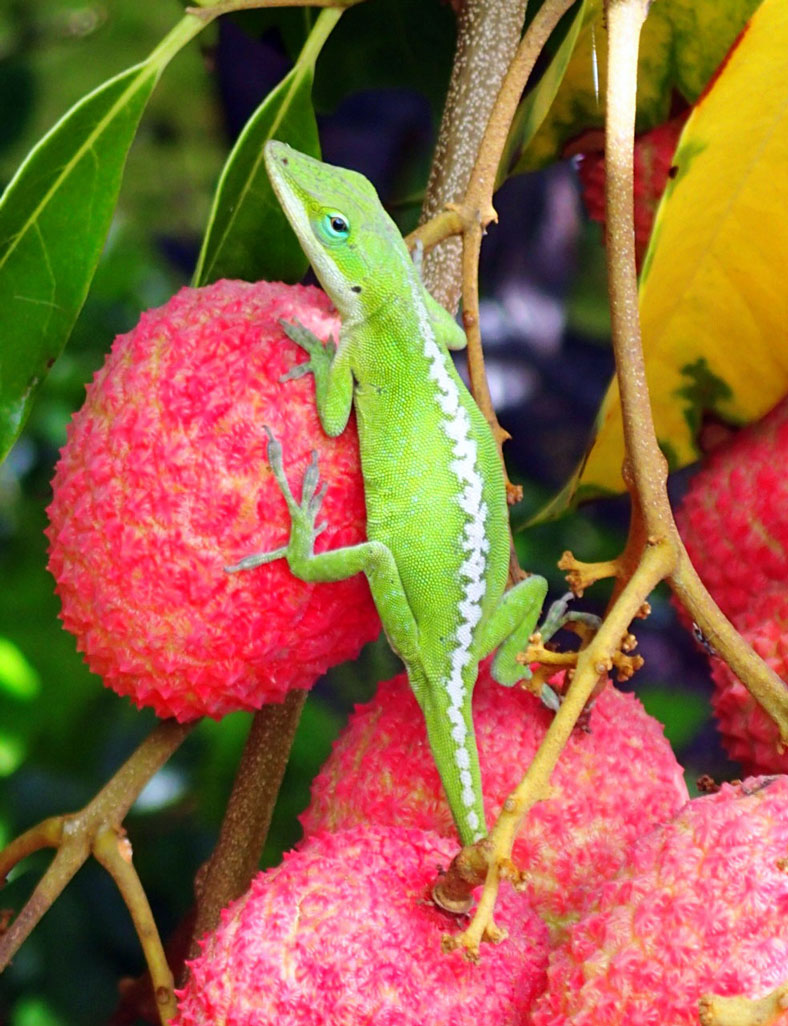
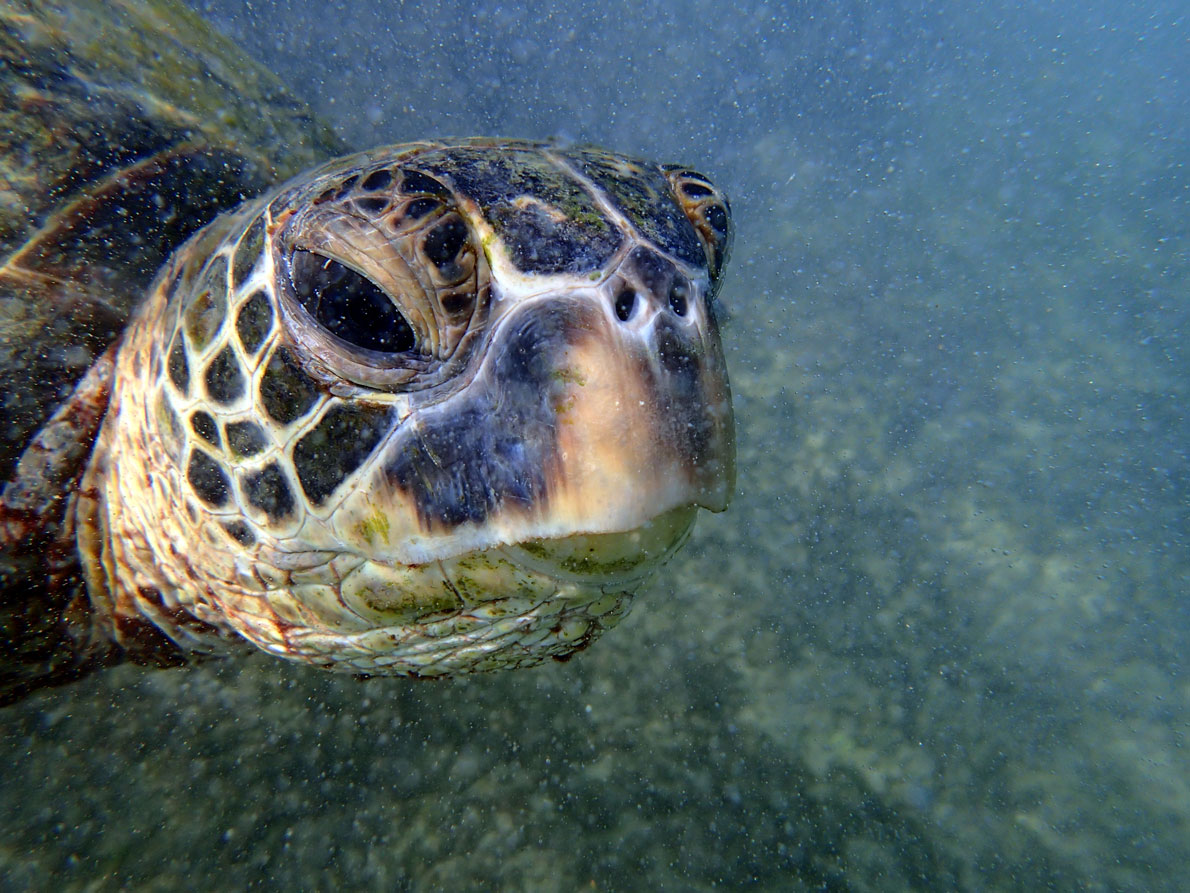
COMMUNITY NATURE JOURNAL ENTRIES
‘Auku ‘u
A very still night here in Pukalani, with no breeze, and little sound, was just livened up by the sharp cry of an approaching `auku`u, a black-crowned night heron. It cried out once as it approached, again when just about overhead, and once more as it trailed off. The pitch of those three cries painted an image of how fast the bird was traveling, and the direction. Alas I was in the house -- I would have liked a chance to have seen it silhouetted against the moon.
Recently I took a long walk down the gulch, and to my surprise startled three or four `auku`u that had been roosting in some tall inia trees. I was surprised to see them so far from the beach or a wetland, but then I remembered the ponds and miles of ditches that run through the cane fields.
The neighbors said that a while back a great blue heron built its nest in a lone inia tree behind our house. I had to wonder if it was really a night heron, since when their necks are elongated someone who was not observing closely could confuse the two. Do you ever see great blue herons on Maui?
Two bucks
Two young axis deer bucks with fresh velvety antlers
Heads emerging above the meadow grass
In the weird blue light of a voggy sunset
Kihei Floods
Happy Face Spider in Waikamoi
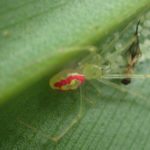 A happy-face spider found beneath a large Himalayan ginger leaf, at the edge of the Waikamoi Preserve on Haleakala. Complete with a mass of eggs and a shriveled up fly.These spiders are one of the evolutionary wonders of Maui.
A happy-face spider found beneath a large Himalayan ginger leaf, at the edge of the Waikamoi Preserve on Haleakala. Complete with a mass of eggs and a shriveled up fly.These spiders are one of the evolutionary wonders of Maui.
See http://evolution.berkeley.edu/evolibrary/article/happyface_02
So get out there and turn over a leaf…
Madeline and Lester
Rotating Mating — Mating Rotating
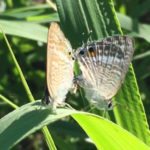 Some slight movement caught my eye. Turned out to be a pair of pale blue butterflies doing a circular mating dance.
Some slight movement caught my eye. Turned out to be a pair of pale blue butterflies doing a circular mating dance.
I love the rich detail, the false eyespots and antennae, the shaggy wing edges, the powerful little feet, and the exquisite clumsiness of the whole affair.
After some investigation, I believe this is Lampides boeticus, the "Long-tailed Pea-Blue Butterfly".
Wiliwili White-Eye
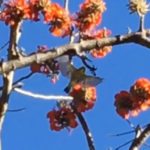 Japanese white eye visits Wiliwili blossoms -- A'apueo Gulch.
Japanese white eye visits Wiliwili blossoms -- A'apueo Gulch.
I wonder which of the native birds might have visited these flowers?
The white-eyes do knock a bunch of blossoms off the trees -- I think they are going for insects -- not sure if there is any nectar that attracts them.
A Wiliwili tree in bloom silhouetted against the morning sky is one of my new favorite things.
Magic moment at Makahiku Falls
Took the Girl Scouts camping and on Friday morning we hiked the Pipiwai Trail up Oheo Gulch above the Seven Sacred Pools. After a short hike we reached the lookout for the mist-shrouded Makahiku Falls. Against the brilliant green backdrop of the bamboo forest, the falls plummeted into the bowl far below. Just then a pair of white-tailed tropicbirds flew up the gulch and circled in front of the falls, their long tail feathers streaming behind them. Epic.
Much ado about Tropical Storm Darby
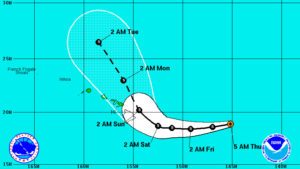 There had been much ado about the approach of Tropical Storm Darby, and I admit part of me was looking forward to something exciting. Since the Aapueo Gulch burned last month we have had a dry summer, with only the briefest of rain showers. Until this morning when the leading spiral band of the approaching storm crossed over Maui. All morning long white veils of fine rain have moved in diagonal sheets across the bleak black landscape.
There had been much ado about the approach of Tropical Storm Darby, and I admit part of me was looking forward to something exciting. Since the Aapueo Gulch burned last month we have had a dry summer, with only the briefest of rain showers. Until this morning when the leading spiral band of the approaching storm crossed over Maui. All morning long white veils of fine rain have moved in diagonal sheets across the bleak black landscape.
I decided to stop looking at satellite images of the storm and go for a walk instead on the flat benchland between the backyards of our street and the edge of the gulch.
There has been so little growth here in the last couple months, mainly some tender blades of grass that have emerged from scattered blackened tussocks, and a few basal sprouts from the charred trunks of shrubs that remain standing. And those few fresh greens have been repeatedly clipped by the forlorn deer that come ambling through.
During the fire nearly all the haole koa shrubs that predominate here were killed. But as a parting gift, their dry pods opened and left thousands of seeds scattered over the land. Like small brown watermelon seeds, they have just sat there baking in the sun, hard and immobile on the dark carpet. Until today. By midday today we had a good soaking, and both earth and seeds are finally hydrated. The seeds have swollen up and softened, and have attracted flocks of well over a hundred spotted doves.
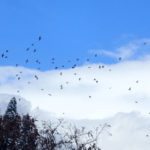 The grey doves took flight as a group every time I neared them, and then landed further ahead or circled behind me. I realized these are likely the largest flocks of any bird I have seen on the wing in Hawaii! I have seen the albatross gathered on the ground at Kaena Point on Oahu, and small flocks of cattle egrets pass overhead daily. I have seen fluttering groups of little birds in the grassland, and the mynah birds on our roof, but barely anything worth calling a flock. I know some of the northwestern islands are mobbed by roosting sea birds, but what about birds of the uplands? Were there ever large flocks here?
The grey doves took flight as a group every time I neared them, and then landed further ahead or circled behind me. I realized these are likely the largest flocks of any bird I have seen on the wing in Hawaii! I have seen the albatross gathered on the ground at Kaena Point on Oahu, and small flocks of cattle egrets pass overhead daily. I have seen fluttering groups of little birds in the grassland, and the mynah birds on our roof, but barely anything worth calling a flock. I know some of the northwestern islands are mobbed by roosting sea birds, but what about birds of the uplands? Were there ever large flocks here?
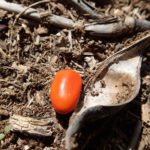 Also puffed up by the moisture are the brilliant red seeds of the wiliwili tree. There aren't many of these, maybe a dozen or two scattered beneath a parent tree. Hopefully some of the pinto bean-sized seeds will sprout and take hold. I see no young wiliwili in the gulch, only the elders' with their yellow bark and fat thorns, scarred and deformed by prior insect attacks. It may be my imagination but it appears that the bark on the canopy limbs is more greenish than normal -- maybe a photosynthetic response to the fire? Or just a way to soak in solar energy in the dry times.
Also puffed up by the moisture are the brilliant red seeds of the wiliwili tree. There aren't many of these, maybe a dozen or two scattered beneath a parent tree. Hopefully some of the pinto bean-sized seeds will sprout and take hold. I see no young wiliwili in the gulch, only the elders' with their yellow bark and fat thorns, scarred and deformed by prior insect attacks. It may be my imagination but it appears that the bark on the canopy limbs is more greenish than normal -- maybe a photosynthetic response to the fire? Or just a way to soak in solar energy in the dry times.
In a hopeful sign, one of the trees that was caught in the fire and sports a blackened trunk has put out some new growth with pale green leaflets. I am always rooting for the survival of the wiliwili here, especially since they are the main reminder of the diverse tropical dry forest that once covered the lower leeward slopes of Haleakala.
As for an exciting storm, I was only hit by only a couple decent gusts, and then the sun came out.
That crazy gnat vortex thing
Out over the gulch's sloping wall are towering clouds of gnats in the late afternoon light. Sometimes they briefly organize into a vortex shape, before dissipating back into a chaotic cloud. Ephemeral moments of order and splendor.
Song of the Cane Toad
Cane toads have been singing their percussive gargling song in the evenings. Why now? Is it the time of year, or just a matter of how low the flow is in the irrigation ditch? Or is there some other factor that has inspired them?
Wildfire!
The weather had been dry, and the trade winds were blowing strong. A brush fire started and spread quickly -- torched the gulch and fields below Pukalani. Lots of excitement with fire trucks, helicopters, and the neighbors all coming out to lend a hand.
Haleakala at night
Jacaranda trees are in full bloom on the drive up to Haleakala.
After nightfall the call of the u'au lends an extraterrestrial vibe to the crater's edge.
Halfway through the night the heart of the Milky Way rose into view over the ridge -- spectacular view of the home galaxy.
Front Yard Avocado Happenings
Strong trade winds are blowing pea- to grape-sized avocados off the tree by the driveway. [November update: The harvest has been bountiful over the last couple months. February 2017 update -- the harvest just ended.].
First Jacaranda Blooming
First jacaranda tree in full bloom along the A'apueo Parkway in Lower Kula. Purple and green star apples were on display at farmers market, along with Sharwil avocados.
Cherry Blossom Riot
Suriname cherry trees are in peak bloom, attracting a riotous crowd of bees. The buzzing has been loud enough to wake me in the morning, and the sweet fragrance is wafting throughout the house.
Agave in bloom
Axis deer fawns
Axis deer fawns scampering around, running circles on the grassy gulch floor. Seem to be testing out their young legs to see what they can do.
Pueo Nui Keiki
As night falls a baby barn owl cries out incessantly from its sheltered grotto high up on the gulch wall. It repeats its sharp raspy call around 100 times a minute, imploring its mother to bring another mouse! Feed me!



